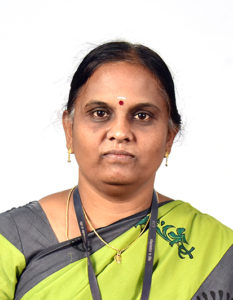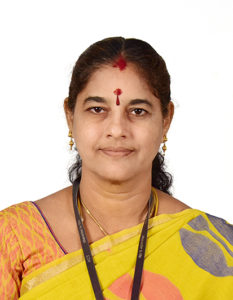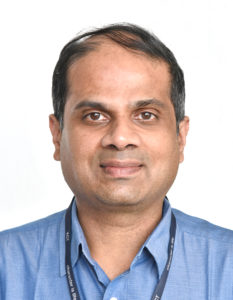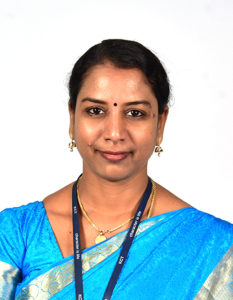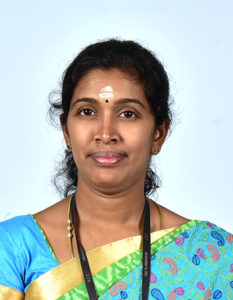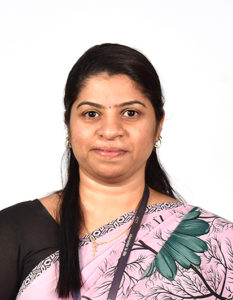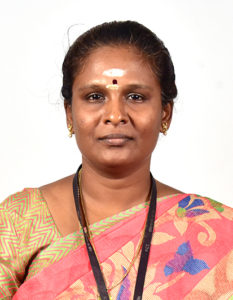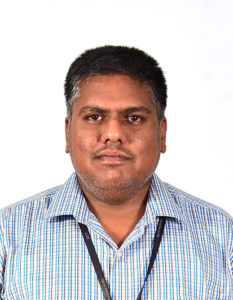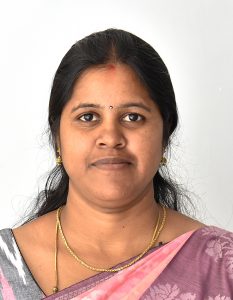About the Department
The Department of Information Technology was established in 1998 with the objective of imparting quality education in the field of Information Technology. Since its inception, the department has expanded and grown in terms of dissemination of knowledge within and outside curriculum and skill development activities. The Curriculum review and modernization of the labs are conducted constantly so as to keep the students updated with the latest trends at the global level. The class rooms are well equipped with all modern electronic audio-visual facilities.
From the HOD’s Desk
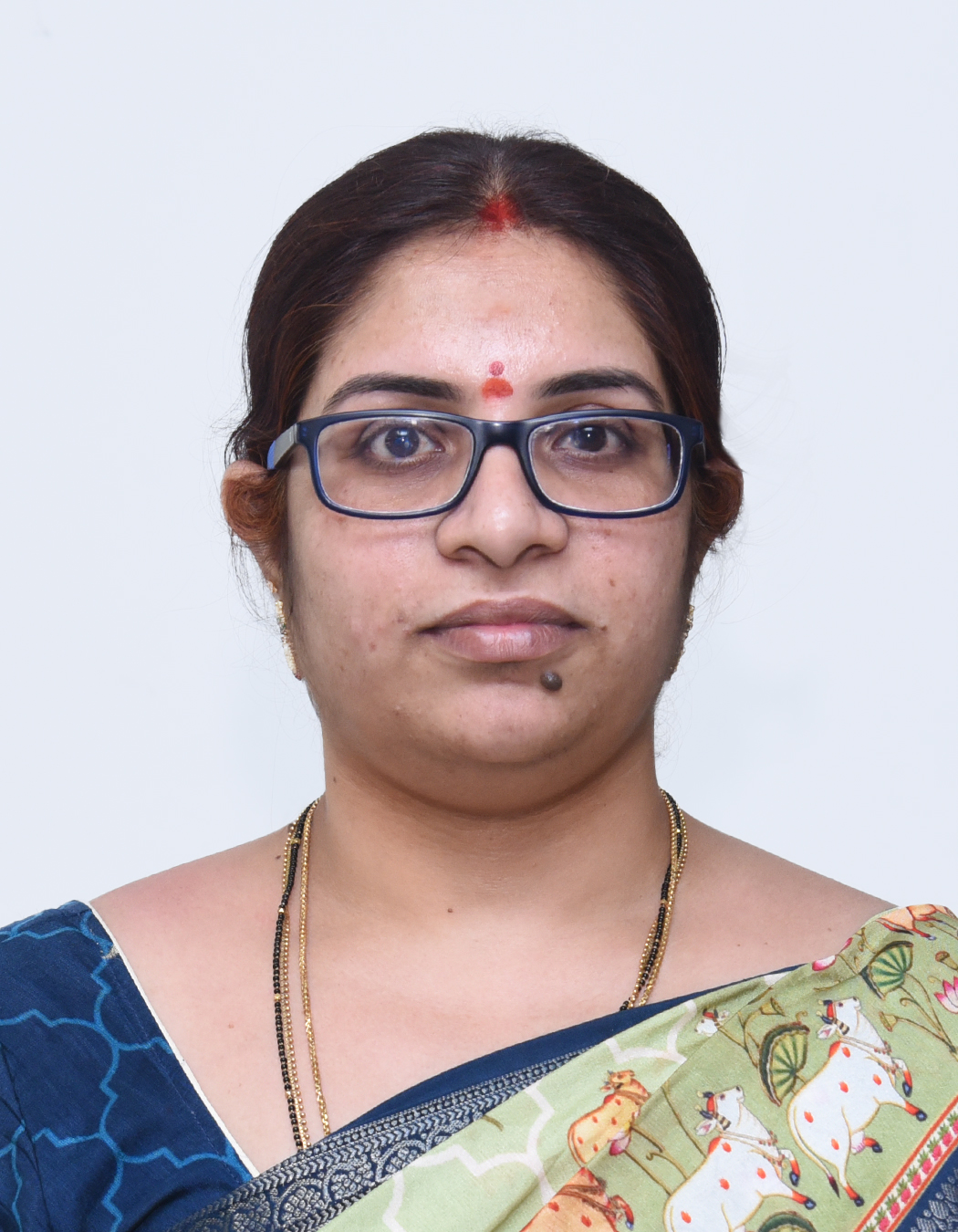
Dr. Divya Vadlamudi,
Professor & Head Incharge
The Department of Information Technology lays greater emphasis on training the students to achieve specialised skills in domains of their choice. The department ensures a career oriented future through Industry internships, certification courses and workshops.Industry designed courses such as Mobile applications programming, Business intelligence and its applications, Building enterprise applications are offered to make our students updated and special care is taken to encourage the young entrepreneurs with start-up ideas. The department records over 95% placements every year.Our students are encouraged to look around them to identify any social issues and our faculty guides them to develop technology for solving those issues. Winning national awards from Tamil Nadu State Council for Science and Technology and Institute of Engineers (India) have increased the enthusiasm of our students in implementing these assistive technology projects.
Vision
The department of Information Technology aspires to become a school of excellence in providing quality education, constructive research and professional opportunities in Information Technology.
Mission
- To provide academic programs that engage, enlighten and empower the students to learn technology through practice, service and outreach.
- To educate the students about social responsibilities and entrepreneurship.
- To encourage research through continuous improvement in infrastructure, curriculum and faculty development in collaboration with industry and institutions.
-
- B.Tech Information Technology 1st to 8th – R18
- B.Tech Information Technology 1st and 2nd semester – R17
- B.Tech Information Technology 3rd to 8th – R17
- B.Tech Information Technology 1st and 2nd semester – R15
- B.Tech Information Technology 3rd to 8th semesters – R15
- B.Tech Information Technology 1st and 2nd semester – R14
- B.Tech Information Technology 3rd to 8th semesters – R14
- B.Tech Information Technology 3rd and 4th semester – R13
- B.Tech Information Technology 5th to 8th semesters – R13
- B.Tech Information Technology – R2009
- UG – B. Tech Information Technology 4 Years (8 Semesters)
- PG – M. Tech Data Science 2 Years (4 Semesters)
-
B Tech (Information Technology)
Tech (Information Technology) is a skill oriented 4-year under-graduate programme and focuses on application engineering. The curriculum is flexible with professional core and electives, humanities, basic sciences, engineering sciences and open electives. Recent technologies like machine learning, Deep learning, artificial intelligence, IoT, cloud computing, data analytics, Big Data are included in the curriculum. The syllabus is designed on par with IITs and top universities to meet the current industry needs. The courses are offered in embedded mode. It also includes a semester-long project work and opportunities for internship with industries. Students are benefitted by getting good placement offers in top companies and scholarships based on merit.
-
M Tech (Data Science)
Tech (Data Science) is a full-time 2 year post graduate programme. Data Science is becoming one of the popular technologies in the world. This program is offered for students from various backgrounds like Mathematics, Statistics, B.E./B. Tech etc., The curriculum is designed in such a way that students can acquire the skills and talents required for a Data Scientist. The courses are in the latest technologies like machine learning, deep learning, big data, data visualization, artificial intelligence, data science, social media analytics etc. More number of practical oriented courses are offered, and the students are encouraged to take up collaborative projects with industries resulting in placement offers. Alumni are provided with financial support and meritorious students are awarded with scholarships every year.
B Tech(IT)
PROGRAM EDUCATIONAL OBJECTIVES (PEOs)
- PEO1: Graduates will have progressive learning and successful career in Information, Communication Technologies and their applications
- PEO2: Graduates will be leaders in their chosen field
- PEO3: Graduates will utilize the acquired technical skills and knowledge for the benefit of society
PROGRAMOUTCOMES (POs)
- PO1: Engineering knowledge: Apply the knowledge of mathematics, science, engineering fundamentals, and an engineering specialization to the solution of complex engineering problems.
- PO2: Problem analysis: Identify, formulate, research literature, and analyze complex engineering problems reaching substantiated conclusions using first principles of mathematics, natural sciences, and engineering sciences.
- PO3: Design/development of solutions: Design solutions for complex engineering problems and design system components or processes that meet the specified needs with appropriate consideration for the public health and safety, and the cultural, societal, and environmental considerations.
- PO4: Conduct investigations of complex problems: Use research-based knowledge and research methods including design of experiments, analysis and interpretation of data, and synthesis of the information to provide valid conclusions.
- PO5: Modern tool usage: Create, select, and apply appropriate techniques, resources, and modern engineering and IT tools including prediction and modeling to complex engineering activities with an understanding of the limitations.
- PO6: The engineer and society: Apply reasoning informed by the contextual knowledge to assess societal, health, safety, legal and cultural issues and the consequent responsibilities relevant to the professional engineering practice.
- PO7: Environment and sustainability: Understand the impact of the professional engineering solutions in societal and environmental contexts, and demonstrate the knowledge of, and need for sustainable development.
- PO8: Ethics: Apply ethical principles and commit to professional ethics and responsibilities and norms of the engineering practice.
- PO9: Individual and team work: Function effectively as an individual, and as a member or leader in diverse teams, and in multidisciplinary settings.
- PO10: Communication: Communicate effectively on complex engineering activities with the engineering community and with society at large, such as, being able to comprehend and write effective reports and design documentation, make effective presentations, and give and receive clear instructions.
- PO11: Project management and finance: Demonstrate knowledge and understanding of the engineering and management principles and apply these to one’s own work, as a member and leader in a team, to manage projects and in multidisciplinary environments.
- PO12: Life-long learning: Recognize the need for, and have the preparation and ability to engage in independent and life-long learning in the broadest context of technological change.
PROGRAM SPECIFIC OUTCOMES (PSOs)
- Technical Skills: Apply the fundamental knowledge to develop computer based solutions in the areas related to information management and networking.
- Leadership Skills: Demonstrate professionalism and ethics in managing academic/ non-academic activities as a team and an individual.
- Social Responsibility: Develop attitude to understand the societal issues and apply the acquired professional skills to provide feasible IT based solutions
M Tech(DS)
PROGRAMEDUCATIONAL OBJECTIVES (PEOs)
- PEO1 :Graduates of the program will be employed in industry, government and entrepreneurial endeavors to have a successful professional career.
- PEO2 :Graduates of the program will pursue higher education and /or research.
- PEO3 :Graduates of the program utilize the acquired technical skills and knowledge for the benefit of society.
PROGRAMOUTCOMES (POs)
- PO1 :An ability to independently carry out research /investigation and development work to solve practical problems
- PO2 :An ability to write and present a substantial technical report/document
- PO3 :Students should be able to demonstrate a degree of mastery over the area as per the specialization of the program. The mastery should be at a level higher than the requirements in the appropriate bachelor program
PROGRAM SPECIFIC OUTCOMES (PSOs)
- PSO1: Understand the various processes involved in application development in the
- Context of data science.
- PSO2: Develop realistic solutions to meet the requirements of the society and the industry using the acquired data analytics skills.
Department has spacious laboratories, equipped with hardware and software facilities to perform the necessary experiments as per the curriculum. There are 149 computer systems including 2 servers. Along with curricular activities, co-curricular events like workshops, project competitions, hackathons, internships, project reviews are conducted in the laboratory. The laboratories are used for all types of UG / PG projects and Ph.D. related research works.
Network Laboratory
Network Laboratory is equipped with 36 computer systems. The laboratory has an HP server to support functionalities of the systems connected in the network. Laboratory offers an integrated education in computer networks, protocol implementations, mobile app development, web application development, cloud computing, big data technologies. Specialized training and events related to network technologies are conducted in the laboratory.
Software Engineering Laboratory
Software Engineering Laboratory is equipped with 36 state-of-the-art computer systems. Students work on Windows and Linux platforms. Laboratory focuses on software development including the front-end technologies Java, PHP, JavaScript, CSS and back-end technologies MySQL, MS-Access. The laboratory provides software engineering artefacts at all stages of the software life cycle.
RDBMS Laboratory
RDBMS Laboratory has 36 computers to support the students in practical learning. Students are exposed to various database management systems – SQL and NoSQL databases. Students learn Oracle, MySQL based database management systems and acquire skills to analyse the software requirements and produce a suitable database model.
Real Time Systems Laboratory
Real Time Systems Laboratory imparts hands on training with Microprocessors and other hardware related technology. The laboratory is equipped with basic microprocessor/ microcontroller kits along with application development kits using RFID and FPGAs. ARM kits, Arduino boards and Raspberry pi boards helps the student to carryout IoT based experiments and projects. The students are trained in the development, testing and design of simple automation systems.
Data Science Laboratory
Data Science Laboratory is equipped with 12 computer systems. The laboratory focuses on applying Machine Learning, Deep Learning, Data Mining concepts to real-world problems in academics, society, and industry. There is a GPU server to support projects. The laboratory houses various toolkits to upskill with new data science techniques and business-focused applications. Few collaborative research projects are carried out with the support of internal and external experts.
Web Technology Laboratory
Web Technology Laboratory is equipped with 17 computer systems supporting the web-based technologies. Students are exposed to the latest web technologies to develop their projects. Several inhouse web projects are developed by the students as part of curriculum and beyond the curriculum. In addition, the laboratory acts as a Pearson VUE Test Centre to take up the certification course exams.
Classrooms:
The department has 5 classrooms for B. Tech(IT) and M. Tech(Data Science) students, equipped with overhead projectors and internet facility.
| Faculty involved | Activities |
| Dr. V. Vanitha, Professor
Mr. M. Vivek Anand |
Network and IoT |
| Workshops/ Conferences conducted – 5
Faculty with Ph.D – 1 and pursuing – 1 Papers published in Journals/ Conferences – 37 |
|
| Dr. N. Rajathi, Professor
Dr. Thirumal , ASP Ms. G. PremaArokia Mary, AP II |
Cyber security |
| Workshops/ FDPs/Industry meet conducted – 5
Faculty with Ph.D -2 and pursuing- 1 Papers published in Journals/ Conferences- 24 |
|
| Dr. M. Alamelu, ASP
Dr. R. Karthikeyan Mr. A. Bhuvaneshwaran Ms. S. Sathyavathi, AP(SRG) Dr. P. Shenbagam, AP II Ms. S. Kavitha, AP II Mr. S. Kanagaraj, AP II |
Data Analytics |
| Workshops/ FDPs conducted – 3
Faculty with Ph.D -2 and pursuing – 3 Papers published in Journals/ Conferences- 32 |
Journal Publication 2022 – 2023
- S.Kavitha, B.Dhanapriya, “Literature Survey on Semantic Segmentation”, International Journal of Science & Engineering Development Research (www.ijrti.org), ISSN:2455-2631, Vol.7, Issue 6, page no.1827 – 1829, June-2022,
- Shenbagam, P., Rajkumar, N. Predicting individual tree mortality in tropical rain forest using decision tree with improved particle swarm optimization. Int J Syst Assur Eng Manag (2022). https://doi.org/10.1007/s13198-022-01706-1
- V.Vanitha, Leaf Disease Detection using Ensemble,International Journal of Innovative Research in Science, Engineering and Technology (IJIRSET),Volume 11, Issue 8, PP.10638-10647, August 2022,DOI:10.15680/IJIRSET.2022.1108027
- P.Shenbagam, N.Sanjana, Corn Leaf Disease Detection: A Survey/ 5th International Conference on Inventive Computation Technologies/ ICICT 2022 Proceedings/ pp 1287-1294
- P. Thirumal and L. Shylu Dafni Agnus, “Forest Fire Detection and Prediction – Survey,” 2022 International Conference on Inventive Computation Technologies (ICICT), 2022, pp. 1295-1302, doi: 10.1109/ICICT54344.2022.9850518.
- P.Shenbagam, NR Narendran, M Sayed Sohail Haque, S Shameem Ahamedh, IoT Based Women Safety System/ International Journal of Recent Advances in Multidisciplinary Topics/ ISSN: 2582-7839, volume 3, issue 6, pp 80-82/ June 2022
- P.Shenbagam, M. Deva Kalyan Reddy, G. Suthir, D. Navin, Furniture Simulator Using Augmented Reality/ International Journal of Recent Advances in Multidisciplinary Topics/ ISSN: 2582-7839, volume 3, issue 6, pp 83-86/ June 2022
- P.Shenbagam, N.Sanjana, Detection of Corn Leaf Diseases Based on Multiple Deep Learning Techniques/ 1st International Conference on Contemporary Progress in Engineering and Technology (ICCPET 22)/ ISBN No: 789356 363373, pp. 42-46, June 2022
- S.Sathyavathi, Yoganarshaminan,Vasumathi. A, Smart Attendance System using Machine Learning / 1st International Conference on Contemporary Progress in Engineering and Technology (ICCPET 22)/ ISBN No: 789356 363373, pp. 26-30, June 2022
- S.Sathyavathi, Kaliraj,Nithyavishal,Kumaran, Web Application for crop Yield production/ 1st International Conference on Contemporary Progress in Engineering and Technology (ICCPET 22)/ ISBN No: 789356 363373, pp.297-301, June 2022
- Kavitha S, Shalini R, Harini Sree N, Akash J,” A SURVEY ON SKIN DISEASE PREDICTION”,Vol 04, 11, DOI https://www.doi.org/10.56726/IRJMETS31716
- A survey on Apple Leaf Disease Prediction /International Research Journal of Modernization in Engineering Technology and Science /Vol 4/ Issue 11 / pp. 2144 – 2149/ DOI : https://www.doi.org/10.56726/IRJMETS31839
- Wild animal detection system /International Research Journal of Modernization in Engineering Technology and Science /Vol 4/ Issue 11 / pp. 690-694/ DOI : https://www.doi.org/10.56726/IRJMETS32017
- A review on machine and deep learning classification techniques for monkey pox detection/ International Journal of Research and Analytical Reviews/ Vol 9/ Issue 4/ pp. 504-507
- Vanitha, V., Srinidhi, R., Darshana, R., & Nivetha, S. K. M. (2022, October). COVID-19 Detection using CT-Scan. In 2022 IEEE 3rd Global Conference for Advancement in Technology (GCAT) (pp. 01-05). IEEE.
- Kiran Shrinivaas, S., Mukesh Varman, D. K., Rahul Karthik, A. U., & Vanitha, V. BLOCKCHAIN IN HEALTHCARE DATA. DOI LINK : 10.56726/IRJMETS32166 https://www.doi.org/10.56726/IRJMETS32166
- Ms Sathyavathi S, Prathikshaa S, Dharshini AJ, Logendar ,A survey on age prediction using skin attributes
DOI LINK : 10.56726/IRJMETS32014 https://www.doi.org/10.56726/IRJMETS32014 - Dr. Thirumal PC, Sruthi K, Dhivya R, Santhosh Sivan V, A SURVEY ON SIGN LANGUAGE TANSLATOR, DOI LINK : 10.56726/IRJMETS31026 https://www.doi.org/10.56726/IRJMETS31026
- R. Gokul, E. Nagul Vijay2, R. Bharathi Raj3, Thirumal P C, Blood Donor App Using Flutter for Blood Donation ,International Journal of Recent Advances in Multidisciplinary Topics
- P.Shenbagam, N.Sanjana, Detection of Corn Leaf Diseases Based on Multiple Deep Learning Techniques/ 1st International Conference on Contemporary Progress in Engineering and Technology (ICCPET 22)/ ISBN No: 789356 363373, pp. 42-46, June 2022
- K. E. S. Sailesh, R. Akshay, S. Akash, and N. Rajathi, “Enterprise Resource Planning for a Manufacturing Industry”, IJRAMT, vol. 3, no. 6, pp. 58–62, Jun. 2022.
- S. Kanagaraj, M. S. Hema, M. N. Guptha and V. Namitha, “Detecting Parkinson’s Disease with Image Classification,” 2022 IEEE 3rd Global Conference for Advancement in Technology (GCAT), Bangalore, India, 2022, pp. 1-5, doi: 10.1109/GCAT55367.2022.9971993.
Journal Publication 2021 – 2022
- S. Kavitha, N. Sanjana, K. Yogajeeva and S. Sathyavathi, “Speech Emotion Recognition Using Different Activation Function,” 2021 International Conference on Advancements in Electrical, Electronics, Communication, Computing and Automation (ICAECA), 2021, pp. 1-5, doi: 10.1109/ICAECA52838.2021.9675789.
- Thirumal. Pc, V. Namitha and L. Shylu Dafni Agnus, “Recommendation System with Different Algorithms,” 2021 International Conference on Advancements in Electrical, Electronics, Communication, Computing and Automation (ICAECA), 2021, pp. 1-5, doi: 10.1109/ICAECA52838.2021.9675479.
- P. Thirumal, L. Shylu Dafni Agnus, N. Sanjana, K. Yogajeeva and V. Namitha, “Speech Recognition Using Data Augmentation,” 2021 International Conference on Advancements in Electrical, Electronics, Communication, Computing and Automation (ICAECA), 2021, pp. 1-5, doi: 10.1109/ICAECA52838.2021.9675607.
- S. Kavitha, B. Dhanapriya, G. N. Vignesh and K. R. Baskaran, “Neural Style Transfer Using VGG19 and Alexnet,” 2021 International Conference on Advancements in Electrical, Electronics, Communication, Computing and Automation (ICAECA), 2021, pp. 1-6, doi: 10.1109/ICAECA52838.2021.9675723.
- S. Kavitha, K. Prakash Kumar, M. Dharshini and S. Sathyavathi, “Medical Mask Detection Using Various CNN Models,” 2021 International Conference on Advancements in Electrical, Electronics, Communication, Computing and Automation (ICAECA), 2021, pp. 1-5, doi: 10.1109/ICAECA52838.2021.9675506.
- S. Kanagaraj, M. S. Hema and M. N. Guptha, “Performance analysis of Classification methods for Parkinson’s Disease with PPMI Dataset,” 2021 International Conference on Advancements in Electrical, Electronics, Communication, Computing and Automation (ICAECA), 2021, pp. 1-5, doi: 10.1109/ICAECA52838.2021.9675588.
- B. K. Mathew, C. Velmurugan and V. Vanitha, “Estimating Most Influencing Parameter in TIG Welding of SS304 using Exploratory Data Analysis,” 2021 International Conference on Advancements in Electrical, Electronics, Communication, Computing and Automation (ICAECA), 2021, pp. 1-4, doi: 10.1109/ICAECA52838.2021.9675521.
- R. Kalaiselvi, K. Meena and V. Vanitha, “Liver Disease Prediction Using Machine Learning Algorithms,” 2021 International Conference on Advancements in Electrical, Electronics, Communication, Computing and Automation (ICAECA), 2021, pp. 1-6, doi: 10.1109/ICAECA52838.2021.9675756.
- K. S. Mounika, S. Deyaradevi, K. Swetha and V. Vanitha, “Music Genre Classification Using Deep Learning,” 2021 International Conference on Advancements in Electrical, Electronics, Communication, Computing and Automation (ICAECA), 2021, pp. 1-7, doi: 10.1109/ICAECA52838.2021.9675685.
- M. N. Ahil, V. Vanitha and N. Rajathi, “Apple and Grape Leaf Disease Classification using MLP and CNN,” 2021 International Conference on Advancements in Electrical, Electronics, Communication, Computing and Automation (ICAECA), 2021, pp. 1-4, doi: 10.1109/ICAECA52838.2021.9675567.
- P. Parameswari, N. Rajathi and K. J. Harshanaa, “LoRa Based Framework to Detect Whitefly Infestation in Coconut Trees,” 2021 International Conference on Advancements in Electrical, Electronics, Communication, Computing and Automation (ICAECA), 2021, pp. 1-5, doi: 10.1109/ICAECA52838.2021.9675775.
- P. Parameswari, N. Rajathi and K. J. Harshanaa, “Machine Learning Approaches for Crop Recommendation,” 2021 International Conference on Advancements in Electrical, Electronics, Communication, Computing and Automation (ICAECA), 2021, pp. 1-5, doi: 10.1109/ICAECA52838.2021.9675480.
- B. Dhanapriya, S. Kavitha, K. R. Baskaran.”Diverse Approach on Image Categorization Using Transfer Learning Methods”, Volume 10, Issue I, International Journal for Research in Applied Science and Engineering Technology (IJRASET) Page No: 1209-1215, ISSN : 2321-9653, www.ijraset.com
- G. Prema Arokia Mary, M. S. Hema, R. Maheshprabhu and M. Nageswara Guptha, “Sentimental Analysis of Twitter Data using Machine Learning Algorithms,” 2021 International Conference on Forensics, Analytics, Big Data, Security (FABS), 2021, pp. 1-5, doi: 10.1109/FABS52071.2021.9702681.
- S R, Naren Mr.; P C, Thirumal Dr.; and D, Sudharson Dr. (2022) “An Optimized Machine Learing Framework For Extracting Suicide Factors Using K-Means++ Clustering,” International Journal of Computer Science and Informatics: Vol. 4: Iss. 3, Article 5. DOI: 10.47893/IJCSI.2022.1197
- Natarajan R, Megharaj G, Marchewka A, Divakarachari PB, Hans MR. Energy and Distance Based Multi-Objective Red Fox Optimization Algorithm in Wireless Sensor Network. Sensors. 2022; 22(10):3761. https://doi.org/10.3390/s22103761
- Prema Arokia Mary, G., Suganthi, N. ,Hema, M. S. ,(2021) Early Prediction of Parkinson’s Disease from Brain MRI Images Using Convolutional Neural Network, Journal of Medical Imaging and Health Informatics,11(12,3103-3109,DOI: https://doi.org/10.1166/jmihi.2021.3897
- Mary, G., Arokia, P., & Suganthi, N. (2022). Detection of Parkinson’s Disease with Multiple Feature Extraction Models and Darknet CNN Classification. COMPUTER SYSTEMS SCIENCE AND ENGINEERING, 43(1), 333-345. https://doi.org/10.32604/csse.2022.021164
- M. Vivek Anand, Dr. Munish Sabharwal, Dr. S Vijayalakshmi ALLEVIATING DATA STORAGE CHALLENGE THROUGH VIRTUALIZATION OF BLOCKCHAIN EMBEDDED WITH INTERNET OF THINGS. (2022). Indian Journal of Computer Science and Engineering, 13(2), 312–323. https://doi.org/10.21817/indjcse/2022/v13i2/221302005
- D. Sudharson, S. Ashfia Fathima, P. S. Kailas, K. S. Thrisha Vaishnavi, S. Darshana and A. Bhuvaneshwaran, “Performance Evaluation of Improved Adaboost Framework in Randomized Phases Through Stumps,” 2021 International Conference on Advancements in Electrical, Electronics, Communication, Computing and Automation (ICAECA), Coimbatore, India, 2021, pp. 1-6, doi: 10.1109/ICAECA52838.2021.9675739
Journal Publication 2020 – 2021
- S. Sathyavathi, R. Dhaaraani, S. Kavitha, G. Prema Arokia Mary. (2020). Detection of Fraudulence Activity Using Smart Cards. International Journal of Advanced Science and Technology, 29(06), 4344 – 4352. Retrieved from http://sersc.org/journals/index.php/IJAST/article/view/18590
- K. S. Asvika, V. Vanitha. (2020). A Deep Learning Approach for Heart Disease Prediction. International Journal of Advanced Science and Technology, 29(06), 4334 – 4343. Retrieved from http://sersc.org/journals/index.php/IJAST/article/view/18589
- Prediction of Customer Churn in Telecom Industry Using Deep Learning Techniques”, International Journal of Emerging Technologies and Innovative Research (www.jetir.org), ISSN:2349-5162, Vol.7, Issue 6, page no.1168-1173, June-2020, Available :http://www.jetir.org/papers/JETIR2006166.pdf
- G.Prema Arokia Mary, K.Saru Priya, N.Suganthi, S.Sathyavathi. (2020). Dopamine Analysis Using Multiple Machine Learning Techniques. International Journal of Advanced Science and Technology, 29(05), 10220 – 10227. Retrieved from http://sersc.org/journals/index.php/IJAST/article/view/21281
- Baskaran,K.R. Sathyavathi,S. Kaarthickkeyan,R. Gangamanikandan, S. Harish,S. (2020). Electromyography Sensor with Virtual Reality Monitoring Muscle Activity. Test Engineering & Management. 83. 18350 -18357
- Baskaran,K.R. Kaviya,B. Kavitha,S. (2020). A Stock Market Prediction System Based on Time Series. Test Engineering & Management. 83.18327 -18338.
- M. Alamelu, T.S. Pradeep Kumar, V. Vijayakumar, Vijayakumar Varadarajan, Piet Kommers, Vincenzo Piuri, and V. Subramaniyaswamy. 2020. Fuzzy rule based SLA generation algorithms for web based multi party negotiation systems. J. Intell. Fuzzy Syst. 39, 6 (2020), 8345–8356. https://doi.org/10.3233/JIFS-189153
- Dr.V.Vanitha,Enhancing the performance of service discovery protocol using minimum spanning tree, International Journal of Mobile Communications Vol 8 / Issue 4 / PP – 443 – 461 https://doi.org/10.1504/IJMC.2020.108307
- Waste separator”, International Journal of Science & Engineering Development Research (www.ijsdr.org), ISSN:2455-2631, Vol.5, Issue 8, page no.282 – 285, August-2020, Available :http://www.ijsdr.org/papers/IJSDR2008035.pdf
- Rajathi N, Vanitha V,Alzheimer Disease Forecasting using Machine Learning Algorithm, Bioscience Biotechnology Research Communications Special Issue Volume 13 No (11) 2020 page no 15-19 ,Doi: http://dx.doi.org/10.21786/bbrc/13.11/4
- Rajathi N, Vanitha ,Heart Disease Prediction Using Machine Learning Algorithms, Bioscience Biotechnology Research Communications Special Issue Volume 13 No (11) 2020 page no 24-27,Doi: http://dx.doi.org/10.21786/bbrc/13.11/6
- Alamelu M, Advancement in Identification and Classification Framework for Malaria Parasite Based on Image Manipulation, Bioscience Biotechnology Research Communications Special Issue Volume 13 No (11) 2020 page no 28-33, Doi: http://dx.doi.org/10.21786/bbrc/13.11/7
- S Sathyavathi, S Kavitha,Breast Cancer Identification Using Logistic Regression,Bioscience Biotechnology Research Communications Special Issue Volume 13 No (11) 2020 page no 34-36,Doi: http://dx.doi.org/10.21786/bbrc/13.11/8
- Rajathi N,Comparative Study of Machine Learning Approaches in Diabetes Prediction, Bioscience Biotechnology Research Communications Special Issue Volume 13 No (11) 2020 page no 42-46
- Rajathi N, Vanitha V, Classification of Mushrooms to Detect their Edibility Based on Key Attributes, Bioscience Biotechnology Research Communications Special Issue Volume 13 No (11) 2020 page no 37-41,Doi: http://dx.doi.org/10.21786/bbrc/13.11/9
- S Kavitha , S Sathyavathi , Malarial Parasite Identification Using Convolution Neural Network , Bioscience Biotechnology Research Communications Special Issue Volume 13 No (11) 2020 page no 52-54, Doi: http://dx.doi.org/10.21786/bbrc/13.11/12
- GPrema Arokia Mary, Predicting Metamorphic Changes In Parkinson’s Disease Patients Using Machine Learning Algorithms, Bioscience Biotechnology Research Communications Special Issue Volume 13 No (11) 2020 page no 147-152, Doi: http://dx.doi.org/10.21786/bbrc/13.11/30
- Prince Jayaseelan C, N.Rajathi, Gokul Surya S, Ranjith Kumar.User Friendly Smart Irrigation System.International Journal of Scientific Research and Engineering Development.Volume 3,Issue 5. Unique Identification Number : IJSRED-V3I5P46
- Dr.N.Suganthi, Dr.N.Rajathi, Dr. V.P.Sumathi. (2020). A Polynomial Based Key Management Scheme forMobile Ad Hoc Networks. International Journal of Advanced Science and Technology, 29(7), 8091-8099. Retrieved from http://sersc.org/journals/index.php/IJAST/article/view/24630
- Saroja MN(2021), Recent Trends in Healthcare about blood donors and patients by using artificial intelligence and IoT / International Journal of Advanced Research in Engineering and Technology / Vol.12 / Issue 3/481-486/ DOI: 10.34218/IJARET.12.3.2021.045
- Naveen Kumar R, Jegan J, Yogesh V, Kavitha S(2021), SALES PREDICTION ANALYSIS, International Research Journal of Engineering and Technology,Volume 8,Issue-3
- S. Kanagaraj, K. Vaishaali, N. Aadish, S. Sudhira, Classification of Diabetic Retinopathy Phase using Convolutional Neural Network, International Research Journal of Engineering and Technology (IRJET), Volume: 08 Issue: 05
- Sandhiya G, Kaushika S, Sujithra R, Sathyavathi S(2021) International Research Journal of Engineering and Technology,Volume 8,Issue-3
- P.Parameswari, N.Rajathi, M.Vijayakumar(2021),”Artificial Neural Networks in Agriculture: A Survey”, INTERNATIONAL JOURNAL OF ADVANCED RESEARCH IN COMPUTER AND COMMUNICATION ENGINEERING, ISSN (Online) 2278-1021. DOI 10.17148/IJARCCE.2021.10102
- G Prema Arokia Mary,Amrithaa D, Santhosh MG, Sowndarya K(2021), Weapon Detection in Video Survillance using Convolutional Neural Network, International Research Journal of Engineering and Technology,Volume 8,Issue-4
- G Prema Arokia Mary, N.Suganthi, Monisha M, Ragapriyaa C, Vignesh N,(2021) Wrist Sensor Based Tremor Diagnosis In Parkinson’s Disease Using Machine Learning Algorithm, Strad Research, Volume 8, Issue 5,2021, https://doi.org/10.37896/sr8.5/014
- G Prema Arokia Mary, N.Suganthi, M S Hema,(2021) A critical Review on Parkinson’s Disease Due to Pesticide Exposure, Strad Research, Volume 8, Issue 5,2021, https://doi.org/10.37896/sr8.5/060
- P.Shenbagam, K.T.HarisKumar, M.Mukesh Kiran (2021),” PREDICTIVE ANALYSIS FOR PRODUCTION LINE USING RNN ALGORITHM”. International Research Journal of Engineering and Technology, ,Volume 8,Issue 5 (pp 3704-3707)
- P.Shenbagam, N.Rajkumar (2021), “AN AMALGAMATION OF DECISION TREE AND COSINE KERNEL SVM FOR THE FIRE DETECTION IN FOREST COVER”, Dynamic Systems and Applications, Volume 30, Issue 6 (pp 1030-1041) https://doi.org/10.46719/dsa20213069
- Thirumal P C , Janani Sri, Shinta C, Naveeth Z A, SURVEY ON INTELLIGENT COVID-19 DETECTION FROM CHEST X-RAYS , International Research Journal of Engineering and Technology, 2395-0056, volume 8, Issue 4, 5206-5212
- Thirumal P C , Janani Sri, Shinta C, Naveeth Z A, NTELLIGENT COVID-19 DETECTION FROM CHEST X-RAYS, International Research Journal of Engineering and Technology, 2395-0056, volume 8, Issue 4, 5213-5218
- Vanitha Veerasamy and V.P. Sumathi Kalaiselvi Rangaraj , Protection of mental healthcare documents using sensitivity-based encryption, Int. J. Cloud Computing , Volume 10, Issue 1, 90-100 https://doi.org/10.1504/IJCC.2021.113992
- R.Hari Haran, Dr. P.C. Thirumal, Dr. G.S. Nandha Kumar “A SURVEY ON DRIVER DROWSINESS DETECTION” Internation Journal for Science and Advance Research In Technology, 7(5)
- K. M. Priyanga and M. Alamelu, “User Request Emotion Prediction Approach in a Crowdsourcing Platform,” 2020 4th International Conference on Trends in Electronics and Informatics (ICOEI)(48184), 2020, pp. 23-29, doi: 10.1109/ICOEI48184.2020.9143021.
- S. Viswanath and N. Rajathi, “On Trend Hybrid Pattern Generation in Fabrics using Machine Learning,” 2020 4th International Conference on Trends in Electronics and Informatics (ICOEI)(48184), 2020, pp. 952-955, doi: 10.1109/ICOEI48184.2020.9143057.
- Aarthi M., Bhuvaneshwaran A. (2021). Iot Based Drainage and Waste Management Monitoring and Alert System for Smart City. Annals of the Romanian Society for Cell Biology, 6641–6651. Retrieved from https://www.annalsofrscb.ro/index.php/journal/article/view/2179
Journal Publication 2019 – 2020
- Sumathi.V.P, Vidyasagr V, Vanitha.V (2019). Asynchronous Learning of Personal Assistant from User Histories Stored in Cloud. International Journal of Innovative Technology and Exploring Engineering (IJITEE). ISSN: 2278-3075, 8 (9S2). 432 – 437
- Kanagaraj,S Hema,M.S. Nageswara Gupta,M. (2019). Machine Learning Techniques for Prediction of Parkinson’s Disease using Big Data. International Journal of Innovative Technology and Exploring Engineering (IJITEE). ISSN: 2278–3075 (Online). 8 (10). 3788-3791
- Prema Arokia Mary, G. Suganthi, N. Hema, M.S. (2019). A Recapitalization on Crypto jacking and end to end Analysis of Ransomware Attacks. International Journal of Engineering and Advanced Technology (IJEAT). ISSN: 2249 – 8958, 8 (6S3). 1582-1586
- Baskaran,K.R. Saroja, M.N. (2019). Human Activity Recognition using Active Learning Methodology. International Journal of Innovative Technology and Exploring Engineering (IJITEE). ISSN: 2278-3075, 8 (12S). 404-406
- S. Kavitha,S. Baskaran, K.R. Sathyavathi,S. (2019). Tasks of Object Detection using Deep Learning Architectures. International Journal of Innovative Technology and Exploring Engineering (IJITEE). ISSN: 2278-3075. 8 (12S). 398-400
- Baskaran,K.R. Saroja, M.N. (2019). Machine Learning Algorithms for Human Activity Recognition. International Journal of Innovative Technology and Exploring Engineering (IJITEE). ISSN: 2278-3075. 8 (12S). 401-403
- Kavitha,S. Baskaran, K.R. Sathyavathi,S. (2019). Social Media Data Analysis using Recommendation Algorithms. International Journal of Innovative Technology and Exploring Engineering (IJITEE). ISSN: 2278-3075. 8 (12S). 394-397
- Cynthia,J. Parveen Sultana, H. Saroja, M.N. Senthil, J. (2019). IoT-based Real Time Air Pollution Monitoring System. International Journal of Grid and High Performance Computing (IJGHPC). 11 (4). 28-41
- Nandakumar, G.S. Palanivelu, L.M. (2019). A Research on the Performance of the Diploma Students in the Lateral Entry Scheme of Engineering Degree Program. International Journal of Engineering and Advanced Technology (IJEAT). 8 (6S3). 1587-1588
- Thilagavathy, K.P. Santha, A. Nandakumar, G.S. (2019). Achromatic Colouring of the Central Graph of Some Special graphs. International Journal of Innovative Technology and Exploring Engineering (IJITEE). 8 (11S). 169-171
- Rajathi,N. Kanchana, J.S. Suganthi Malarvizhi,P. (2020). DEPSO Model For Efficient Clustering Using Drifting Concepts. International Journal of Scientific & Technology Research. 9(02). 2781-2783
- Alamelu,M. Balaji,R. Mithun,J. Hariharan,M. (2019). Diabetics Retinopathy Vision Analysis using Image Identification Service Analysis Approach. Procedia Computer Science. 165. 470–477.
- Suresh, A., Ganesh Kumar, P. Optimization of Metascheduler for Cloud Machine Learning Services. Wireless Pers Commun (2020). https://doi.org/10.1007/s11277-020-07367-2
- Abinaya,P.L. Suresh,A. (2020). Improving QoS of the Cloud Load Balance Using Bio-Inspired Optimization Method. Journal of Green Engineering, 10(3). 697 – 712
- Janani, N. Kanagaraj, S. (2020). Diagnosis of Parkinson Disease Using Sensor Data and Machine Learning Approach in Mobile Cloud. Journal of Green Engineering.10(3). 684 – 696
- Kanagaraj, S., Hema, M. S., & Gupta, M. N. (2020). Normalisation and dimensionality reduction techniques to predict parkinson disease using ppmi datasets. Oxidation Communications, 43(1), 117-134.
- Dharneeshkar and V. Vanitha, “Design and Implementation of Novel ECG Acquisition System,” 2019 International Conference on Communication and Electronics Systems (ICCES), 2019, pp. 574-578, doi: 10.1109/ICCES45898.2019.9002369.
- K. S. Asvika, V. Vanitha. (2020). A Deep Learning Approach for Heart Disease Prediction. International Journal of Advanced Science and Technology, 29(06), 4334 – 4343. Retrieved from http://sersc.org/journals/index.php/IJAST/article/view/18589
Journal Publication 2018 – 2019
- Alamelu, M. Sindhuja. Balaji, S. (2018). Automatic water Irrigation System Appro ach for Smart Homes. International Journal of Recent Technology and Engineering. 7 (4S) 318- 320
- Alamelu, M. . Pradeep Kumar, T.S. (2018). Unique Identical Weightage (UIW) Model for Real Time Customer Search Queries. International Journal of Recent Technology and Engineering . 7 (4S). 339-342
- Kavitha, S. Baskaran, K.R. Sathyavathi, S. (2018). Heart Disease with Risk Prediction using Machine Learning Algorithms. International Journal of Recent Technology and Engineering. 7 (4S). 314-317
- Nandakumar, G. S. Viswanandhne, S. (2018). A Survey on Item Selection Approaches for Computer Based Adaptive Testing. International Journal of Recent Technology and Engineering. 7 (4S). 417-419
- Rajathi, N. Suganthi, N. Shilpa, R. (2018). Automatic Electricity Bill Generating System. International Journal of Recent Technology and Engineering. 7 (4S). 08-11
- Suganthi, N. Rajathi,N. Farithul Inzamam, M. (2018). Elephant Intrusion Detection and Repulsive System. International Journal of Recent Technology and Engineering. 7 (4S). 307-310
- Saroja, M.N. Kannan,S. Baskaran,K.R. (2018). Analysing the Purchase Behavior of a Customer for Improving the Sales of a Product. International Journal of Recent Technology and Engineering . 7 (4S). 173-175
- Sathyavathi, S. Baskaran, K.R. Kavitha,S. (2018). Non-Invasive Diabetes Mellitus Detection Using Facial Block Color. International Journal of Recent Technology and Engineering. 7 (4S). 304-306
- Shenbagam,P. Rajkumar,N. (2018). Predictive Analysis for Identifying the Relationship between Forest Cover and Tiger Population. International Journal of Recent Technology and Engineering. 7 (4S). 328-330
- Sumathi, V.P. Vanitha, V. Divyadarshini, M. (2018). GDP based Medal Count Analysis in Summer Olympics Games for Two Decades – An Exploratory Analysis. International Journal of Recent Technology and Engineering . 7 (4S). 12-16
- Vanitha,V. Sumathi, V.P Kalaiselvi , R. (2018). Automatic Ticket Validation System for Indian Railways. International Journal of Recent Technology and Engineering. 7 (4S). 267-271
- Vanitha, V. Sumathi, V.P. Soundariya,V. (2018). An Exploratory Data Analysis of Movie Review Dataset. International Journal of Recent Technology and Engineering. 7 (4S). 380-384
- Maheshprabhu, R. Hema,M.S. Prema Arokia Mary, G. (2018). Information System for Performance Improvement of small and Medium Scale Enterprises. International Journal of Recent Technology and Engineering (IJRTE), -7 (4S2). 407-411
- Kanagaraj S, Hema,M.S. Nageswara Gupta,M. (2018). Environmental Risk Factors and Parkinson’s Disease – A Study Report. International Journal of Recent Technology and Engineering (IJRTE). 7 (4S2). 412 – 415.
- N.Rajathi, S.Kanagaraj, R.Brahmanambika and K.Manjubarkavi,,Early Detection of Dengue Using Machine Learning Algorithms, International Journal of Pure and Applied Mathematics (IJPAM)
- M. Alamelu T. S. Pradeep Kumar , PERM based service Prediction model for Groundwater Level Analysis, International Journal of Recent Technology and Engineering (IJRTE) ISSN: 1748-0345 (Online), Vol-14 Issue- , PP: 1612-1621
Conference
- Organized 2021 International Conference on Advancements in Electrical Electronics Communication Computing and Automation (ICAECA 2021) from 8.10.2021- 9.10.2021
- Organized AICTE sponsored International Conference of “Image Analysis for Human Infectious Diseases” on 06.11.2020 & 07.11.2020
STTP
- Organized STTP on “Enlighten the programming Basics” from 8.9.2020 to 12.9.2020
- Conducted Value Added Programme on App Development using Flutter and Firebase on 12.08.2021 & 28.08.2021
- Conducted Value Added Programme on App Development using Flutter and Firebase on 12.08.2021 & 28.08.2021
- Organized Webinar on Introduction to IT Opportunities for Full Stack Developer on 26.06.2021
- Organized Workshop on Python from 03.09.2021-05.09.2021 and 10.09.2021-11.09.2021
- Conducted Webinar on My Story – Motivational Session by Successful Entrepreneur on 29.11.2021
- Conducted Seminar on Quality Assurance in product development on 31.3.2022
- Conducted event A Talk Session on “Build2Learn” on 12.8.2021
- Conducted Interaction session “Funify Thursday” on 12.08.2021
- Conducted event Online Quiz “PollIt” on 18.10.2021
- Conducted event Project Presentation “Innovate 30 Team Sprint” on 24.10.2021
- Conducted event on Interaction session “Let us Know” on 27.10.2021
- Conducted event on Discussion session “I’30 Retrospection” on 17.11.2021
- Conducted A technical puzzle event “Tech Perplex” on 1.12.2021
- Conducted Project tools discussion “Figma 101” on 2.12.2021
- Organized A quiz game “Clue-In” on 27.01.2022
- Conducted Training – Live Bootcamp on “Build your own Virtual Assistant” on 7.3.2022
- Conducted Guest lecture on Cloud Computing Services using Microsoft Azure on 21.9.2021
- Conducted event Training on Moodle LMS usage on 30.10.2021
- Conducted event Rapid Riddles from 11.06.2021 – 12.06.2021
- Conducted event on Guru Utsav on 7.9.2021
- Conducted event on Why – IT? On 20.9.21
- Conducted event on Brain Whistler on 2.11.2021
- Conducted seminar on Placement Roadmap on 15.11.2021
FDP
- Organized 5 days FDP on Cyber security and Cyber Forensics from 06.09.2021 – 10.09.2021
- Organized 7 days online FDP on Quantum Computing from 31.1.2022 – 6.2.2022
Department Association of Information Technology:
The Department Association aims to strengthen technical knowledge, teamwork and leadership skills of every single student to get success in their carrier. Events will be conducted in regular time periods focusing on various aspects, the students need to build on.
Yugam:
It is a techno-cultural fest usually conducted every year in the month of February. It focuses on bringing out the talents hidden within students. Various technical contests and Interactive Workshops on the latest upcoming technologies will be conducted for students from different colleges.
Guest Lecture/ Hackathon:
We invite experts from industry/academy from different domains to deliver guest lecture to upskill our students in latest tools and technologies. Hackathons/coding contests are organized frequently to flourish coding skills and thriving team spirit.
Placement Activities:
A series of webinars are organized to get the students ready to face Aptitude tests and Interviews during their placements. Our eminent alumni extend their hands to inculcate technical skills and professionalism with their juniors as per the industry expectations.
Social Media:
The Instagram page of the Department Association keeps the students updated on all the activities that happen in the department. It is not only used for the updates but also keeps them tuned with regular posts and facts relating to the field.
Follow us on Instagram: https://www.instagram.com/it_kct/
Funded project
Consultancy Projects
| Year | Number of Consultancy Projects | Amount |
|---|---|---|
| 2021-2022 | 3 | ₹ 6,98,500 |
| 2019-2020 | 6 | ₹ 4,09,367 |
| 2018-2019 | 5 | ₹ 9,97,171 |
Student Internship
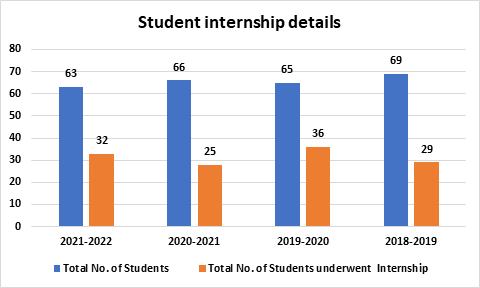
Placement Details
| Academic year | Year of study | Total No of Students | No of Companies Visited | Students placed | Maximum package(Rs) |
| 2021-2022 | 2018-2022 | 63 | 297 | 50 | 11,00,000 |
| 2020-2021 | 2017-2021 | 66 | 209 | 51 | 8,30,000 |
| 2019-2020 | 2016-2020 | 65 | 205 | 42 | 25,00,000 |
| 2018-2019 | 2015-2019 | 69 | 186 | 44 | 19,60,800 |
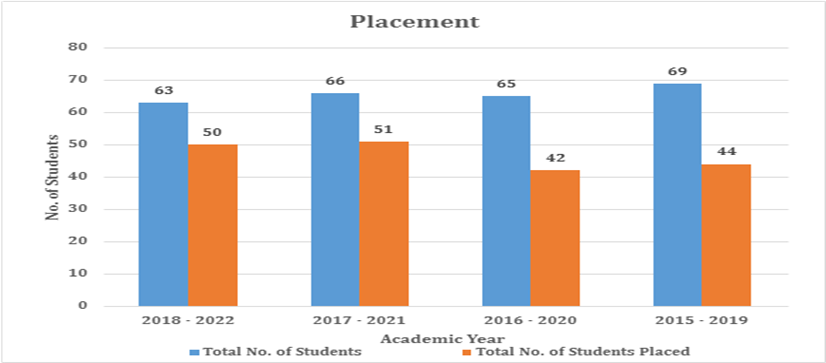
MoU
EMURGO is the official commercial and venture arm of the Cardano project – Mission towards 3rd Generation Blockchain, registered in Tokyo, Japan since June 2017 and in Singapore since May 2018. EMURGO is uniquely affiliated and works closely with IOHK to grow Cardano’s ecosystem globally and promote the adoption of the Cardano blockchain. Blockchain is the latest upcoming technology generating lakhs of jobs in India in coming years. Keeping this in mind to bring the latest cutting-edge technology exposure to our students, IT department has signed up an MoU with EMURGO Academy on 24.10.2020.

